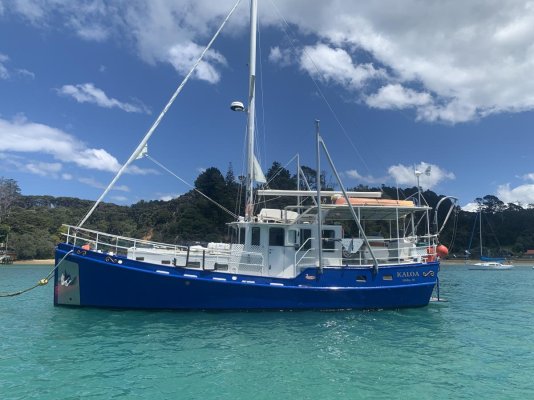Well said Judy, I am not an ex secret service officier of our DGSE but I can tell you that after 7 fiberglass boats ( both sailing and trawler), I do no regret my North Sea Trawler 57' Oc in steel! At the beginning I was a little afraid: how correct minor rusty spots? It is difficult to avoid it, especially in salt waters like Med... I remember watching Dutch owners, looking for their small pencils and little cans in dedicated lockers, like doctor ready to do some meticulous surgery... You need to be patient and slow.
Also, you must adopt a scheme and never change. As you say, with your great experience, keep a work boat look is not so bad. So instead, struggling with Alwgrip or other super shinny paints, I have decided to switch to commercial and profesional products:
- on a rusty spot:
- first , sand, clean etc
- and apply a product like Ferose ( mostly used in restauration of classic cars) ( or other rust converter)
- 2- apply a small coat of Jotun Jotamastic 87 or 90
- 3 - apply some epoxy mastic if necessar
- 4 - apply after that 2 to 3 coats of Jotamastic 87 or 90
- 5 - last, apply 2 to 3 coats of Jotun Hard Top XP with the tint of your choice.
And that s'it. For me it is less harrassing than polishing a gelcoat started to be faded.
Of course, in the Netherlands, I have seen georgous boats painted with Awlgrip. But Netherlands sea or waterways are mostly fresh water, the season is short, and in winter most of the yachts are under shed or completely protected from humidity rain or snow.
With my trawler, if an bloody covid regulation is not stopping us, we are making a lot of miles offshore.
As mentionned, what is crucial is the inside of the yacht.
With the unbelievable temps who have this year everywhere in Europe, I feel definitely more comfortable in my fully insulated trawler with special RAFA windows than in a plastic boat.
Good approach IMO.
Regarding Awlgrip, that is what I have and after 20 years people still ask if she was just painted. A key to maintenance is the color, with white or light gray shades easy to repair and have them blend in with the aged paint around the repair area. My approach is similar to yours:
1. Dremel small areas to be repaired, 60 grit sand for larger areas. Note, 20 years, I've used a sander once on a larger repair area.
2. Apply wash coat of anti-corrosion primer. I use a no longer offered Awlgrip product, but I suspect any anti-corrosion product would do.
3. Apply Awlgrip high build primer with an artist's brush. Because Delfin is faired (epoxy over the steel), once I'm done dremeling or sanding, there is frequently a 20 mil divot that needs to be filled and the high build helps.
4. Sand the high build so none is left above the surrounding level of paint.
5. Apply 3M premium vinyl ester filler. Sand flat with 320 to surrounding paint, then reapply and sand until smooth.
6. If a larger area, apply another thin coat of high build primer to fill any defects, sanding marks, etc. I generally use a brush since the high build won't go through the airbrush without a lot of thinning.
7. Apply Awlgrip 545 primer with an Iwata airbrush.
8. Wet sand with 400 grit.
9. Apply Awlgrip top coat.
10. Wet sand with 600, then 1000, then 2000 to dull and remove overspray.
11. Buff with McGuire swirl remover polishing compound.
This sounds like a lot of steps, but each takes literally seconds to complete, so the total time investment to repair a ding might be 15 minutes, including time to clean the sprayer. Once an area is repaired, you're pretty hard pressed to find it again.
For the first time in 15 years, I'm having the whole boat buffed out with light polishing compound. The result is that she is about 90% as bright as she was when first painted 20 years ago.



